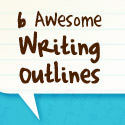The following is a guest post from author Amanda from The Drive. It was first published on her blog on August 17. If you’d like to write a guest post, we’d love to have you! Just shoot us an e-mail or give a shout to @duolit. Now, on to Amanda’s post:
As most of you, dear readers, know, I’m in the final stages of writing my very first manuscript ever. Of course, my next steps would traditionally include the following:
- drafting a query letter
- spending almost as much time editing my query letter as I did editing my novel
- investigating the genres, submission requirements, likes, dislikes, and bathroom rituals of every agent out there
- selecting a few agents to whom I will send my shiny new query
- biting my nails
- piling the rejections on my desk
- biting my nails
- finally landing an agent (hopefully!)
- revising to the agent’s specifications
- …and, well, you know the rest. I won’t bore you.
However, now more than ever, we have so many more OPTIONS. Unpopular options. Options they don’t tell you about on the normal forums. In fact, on one of my (unnamed) writers’ forums, when I brought up the question of what an agent and publisher actually DO these days, I was immediately shot down. Basically, I wondered, if we authors are responsible for the twitter and the blogs and the youtube trailers and much of the book tours, why should we have a publisher? With the new popularity of e-books, it seems that publishers who focus on hard copy books are on their way to becoming somewhat obsolete.
Crazy. I know. Don’t shoot me yet. Just look at Barnes & Noble, one of the largest booksellers in the US who just went up for sale. The new e-book revolution has rattled them to the core and even their answer to it, the Nook, doesn’t seem to be able to save them. As stated in a recent New York Times article, “the threat that has the industry and some readers the most rattled is the growth of e-books. In the first five months of 2009, e-books made up 2.9 percent of trade book sales. In the same period in 2010, sales of e-books, which generally cost less than hardcover books, grew to 8.5 percent, according to the Association of American Publishers, spurred by sales of the Amazon Kindle and the new Apple iPad.”
And, here’s another staggering statistic found in the Guardian: “Amazon now sells twice as many digital books as hardbacks in the US.” It’s looking like more and more people, both companies and independent authors, are moving towards e-publishing. Don’t believe me? How about checking this article at Market Watch. I could give you a slew more, but I’m sure you all have access to google. And frankly, these days this type of article is not difficult to find.
Not only are authors like Ray Connelly (as featured in the Guardian article above) publishing their own books digitally, but some agents are taking advantage. One top agency caused a huge industry conflict by cutting a deal with Amazon (Kindle) for digitally publishing many of their authors’ older works. Check out the NPR interview here.
Scared? I am. When the market is flooded with e-publications by every aspiring author and their grandma, not to mention agents that want to bypass the publisher and publishers trying to remain afloat by going digital, how will my little novel ever get noticed?
That’s a good question. But when you think about it, is it really that much more difficult than sending a 1 page query letter to an agent who receives 150 nearly identical letters a day, hoping to be noticed? I don’t think so. And, with self publishing digitally, you risk nearly nothing (other than your pride, which gets risked in the traditional pathways anyway!). Not to mention, the rights to your story remain your own to do with it whatever you like.
I’m not saying I’m going to self-publish my book, but what I am saying is…it doesn’t look like such a bad option.
Thanks for your perspective on the publishing options available, Amanda! For more from Amanda, visit her blog The Drive or follow her on Twitter @acasile.

 Good writing. Hard work.
Good writing. Hard work.

 We're
We're 








